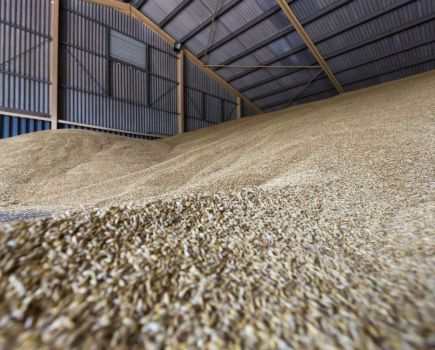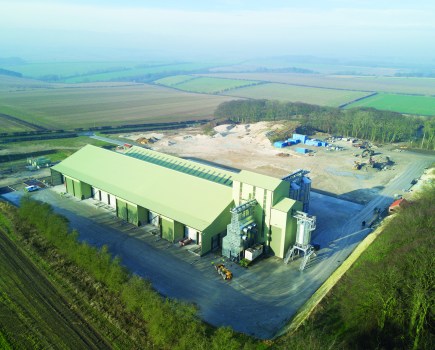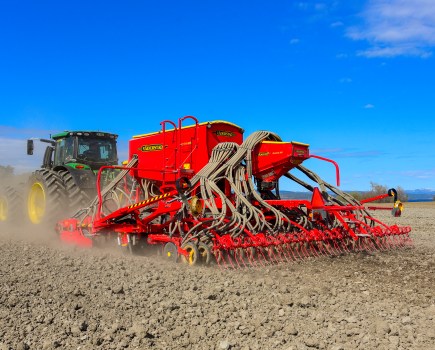As the 200,000th JCB Loadall rolls off the production line, new features are unveiled in its latest range. CPM finds out what they’ll bring to the arable business.
They’ve done away with the torque converter so that there’s now a direct mechanical link.
By Nick Fone
JCB has launched a completely new transmission for its best-selling 7m reach Loadall telehandlers. Dubbed the DualTech VT, it uses a combination of hydrostatic and mechanical drive, something the Staffs-based manufacturer says it’s unique in doing.
It signals something of a departure for the yellow-liveried brand which has doggedly stuck with torque-converter gearboxes for almost its entire mainstream range until recently, while other handler makers have moved towards oil-driven hydrostats.
However the company now concedes that such an approach does have its advantages – namely in low-speed, precision applications around the yard. That said, hydrostatics don’t have the best reputation when it comes to towing, travelling on the road and hill-climbing. Oil pumps and motors might provide ultra-precise inching but they do suffer a degree of power loss.
Ideal compromise
That’s why the British company argues a combination of hydrostatic and mechanical drives offers the ideal
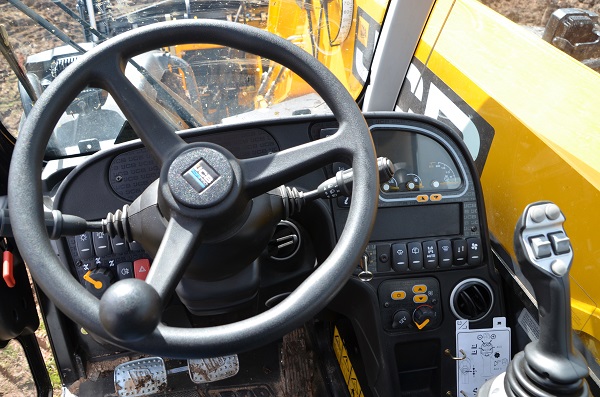
The cab features a new colour dash display.
compromise. Engineers at its transmission factory in Wrexham, North Wales have taken the company’s standard four-speed powershift box, have chucked out first gear and replaced it with a Bosch Rexroth hydrostat unit. They’ve also done away with the torque converter so that there’s now a direct mechanical link all the way through the drivetrain from the engine to the axles when either second, third or fourth ratios are selected. Electronically-modulated clutch-packs shift between each of these powershift steps.
That means ‘AgriPro’-badged Loadalls now have fully stepless hydrostatic drive up to 19km/h. Above this the gearbox automatically switches to the three mechanical, powershift steps taking the machine up to its top speed of 40km/h.
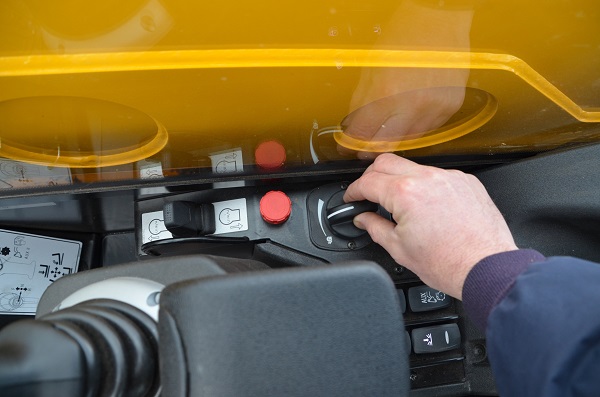
In Flexi mode, a dial adjusts travel speed from 0-19km/h steplessly, next to a toggle-switch that acts as an electronic hand throttle allowing engine rpm to be adjusted in 100rpm increments.
Within the clever control software are a number of different operating modes. In normal ‘Drive’ mode, the accelerator pedal handles both transmission and engine functions with the computer balancing the two according to driver demands and engine loading. The first stage of travel on the brake pedal provides progressive inching, gradually disengaging hydrostatic drive to enable gentle control of forward travel with no wear and tear on the brakes.
In ‘Flexi’ mode, engine speed and ground speed can be controlled independently. In the cab a toggle-switch acts as an electronic hand throttle allowing engine rpm to be adjusted in 100rpm increments. Alongside it, a dial adjusts travel speed from 0-19km/h steplessly – shown as a percentage on the colour dash display.
This allows operators to set engine speed for optimum hydraulic performance tailored to a particular operation while the handler’s ground speed can be regulated simply by the foot pedal, doing away with the need to de-clutch and rev up the engine to get oil-flow to the boom.
Within each of these two driving modes there’s the option to switch between ‘Power’ and ‘Economy’ settings. The former allows the engine to rev to the maximum to provide full oil flow and high rpm for power-hungry tasks while the latter limits the engine to 1700rpm, alters the engine mapping and initiates earlier up-shifts to minimise fuel usage.
The combination of all these features has led JCB to make some pretty bold claims for its new AgriPro handlers. Regenerative hydraulics that harness the energy of the oil flow from the boom in its down-stroke are said to have sped up cycle times by as much as 20%. After 10,000 hours of prototype testing, the combined effect of these new energy–saving functions is reckoned to have cut the amount of fuel used to shift a tonne of material by up to 15%, compared with previous Loadalls.
In addition to the most radical move to the new hybrid transmission, JCB’s ever-popular 7m reach, 3.1t, 3.6t and 4.1t-capacity machines gain a number of other new features. Four-wheel drive now kicks in and out automatically at 19km/h, helping to reduce tyre wear and improve driveline efficiency at speed. There’s a new high-flow third service for auxiliary attachment hydraulics which provides up to 110 litres/min at 190bar and incorporates a pressure-release system at the couplings to aid in swapping between implements.
Boom extend/retract and raise/lower cylinders all get end-stroke damping to smooth hydraulic operations and minimise the risk of load spillage. On top of that, Smooth Ride boom suspension now kicks in and out automatically at 4km/h, making precise placement of loads such as potato boxes and pallets at low speed more accurate and then re-engaging when it’s required as the pace picks up. There’s also an automatic bucket shake function that increases progressively when the joystick is pushed to one side with a button held down. It should help in shifting sticky materials such as muck from buckets or grabs.
While many of these features are now available on more standard Agri Plus and Agri Super Loadalls, it’s only the AgriPro versions that get the DualTech VT gearbox. Combining hydrostatic and mechanical drives clearly has its benefits but those benefits come at a price – these new high-spec models are some 8% more expensive than the previous top-end machines.
Tech specs: JCB AgriPro Loadall
| Model | 531-70 | 536-70 | 541-70 |
| Max lift | 3.1t | 3.6t | 4.1t |
| Lift height | 7m | 7m | 7m |
| Max power | 145hp | ||
| Engine | 4.8-litre JCB EcoMax with AdBlue | ||
| Transmission | DualTech VT combined hydrostatic/powershift, 40kph | ||
| Hydraulics | 140-litres/min variable displacement load-sensing pump, max 260bar pressure | ||
| Weight | 6.9t | 7.8t | 7.8t |
| Turning circle | 7.4m | ||
| Price | £86,876 | £89,700 | £91,860 |
Timeline – 40 years of JCB Loadalls
1976 – Development of new telescopic handler concept reaches prototype stage
1977 – The first JCB Loadall is sold
1981 – First 4wd telehandler – FarmSpecial 525-4 is launched
1988 – Equal-sized wheels and 4-wheel-steering
1996 – Side-engined 526 launched – first telehandler with a turbo
1999 – 120hp AgriSuper is launched with 5-speed powershift and boom suspension
2004 – First of JCB’s own DieselMax engines plus 6-speed gearbox with torque-lock
2006 – 100,000th Loadall is sold
2014 – Regenerative hydraulics introduced
2016 – 200,000th Loadall is built making JCB the world’s biggest telehandler maker.
DualTech VT hybrid hydrostatic/powershift transmission is launched.


